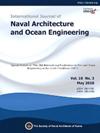船舶与自升式支腿碰撞的简化试验土-支腿相互作用模型
IF 3.9
3区 工程技术
Q2 ENGINEERING, MARINE
International Journal of Naval Architecture and Ocean Engineering
Pub Date : 2025-01-01
DOI:10.1016/j.ijnaoe.2025.100682
引用次数: 0
摘要
由于海上钻井和安装船的扩张,自升式装置最近变得普遍。在大多数先前的研究中,相关自升式钻井平台结构的指导方针已经评估了在安装过程中与土壤结构的相互作用。然而,安全运行条件的设计还必须考虑到在与随行船只和/或过往船只碰撞产生水平冲击载荷的情况下与土壤结构的相互作用。因此,考虑基于风险的钻机基础设计,结合土壤结构特征的研究,以最大限度地减少在操作条件下可能发生的碰撞事故的影响是很重要的。在这项研究中,我们开发了一个基本数据集和对土壤刚度的简化理解,这将使钻机安装过程的模拟能够使用简化的实验模型,包括土壤建模、渗透和冲击。这些数据将用于工业实践的结构设计和风险管理,以及用于高级数值/实验建模和设计指导的进一步验证/校准研究。本文章由计算机程序翻译,如有差异,请以英文原文为准。
A simplified experimental soil-leg interaction model for ship to Jack-up leg collision
Jack-up units have recently become common due to the expansion of offshore drilling and installation vessels. In most previous research, guidelines for related jack-up rig structures have assessed the interaction with the soil structure during installation in terms of penetration of a spudcan. However, the design of safe operating conditions must also take into account the interactions with the soil structure in case of horizontal impact loads from collisions with attendant and/or passing vessels. It is therefore important to consider the risk-based design of rig foundations, incorporating a study of soil-structural characteristics, to minimise the effects of collision accidents that may occur under operating conditions. In this study we develop a fundamental dataset and a simplified understanding of soil stiffness that will enable the simulation of the rig-installation process using simplified experimental models that involve soil modelling, and penetration and impact. These data will be used in structural design and risk management for industrial practices as well as in further validation/calibration studies for advanced numerical/experimental modelling and design guidance.
求助全文
通过发布文献求助,成功后即可免费获取论文全文。
去求助
来源期刊

International Journal of Naval Architecture and Ocean Engineering
ENGINEERING, MARINE-
CiteScore
4.90
自引率
4.50%
发文量
62
审稿时长
12 months
期刊介绍:
International Journal of Naval Architecture and Ocean Engineering provides a forum for engineers and scientists from a wide range of disciplines to present and discuss various phenomena in the utilization and preservation of ocean environment. Without being limited by the traditional categorization, it is encouraged to present advanced technology development and scientific research, as long as they are aimed for more and better human engagement with ocean environment. Topics include, but not limited to: marine hydrodynamics; structural mechanics; marine propulsion system; design methodology & practice; production technology; system dynamics & control; marine equipment technology; materials science; underwater acoustics; ocean remote sensing; and information technology related to ship and marine systems; ocean energy systems; marine environmental engineering; maritime safety engineering; polar & arctic engineering; coastal & port engineering; subsea engineering; and specialized watercraft engineering.
 求助内容:
求助内容: 应助结果提醒方式:
应助结果提醒方式:


